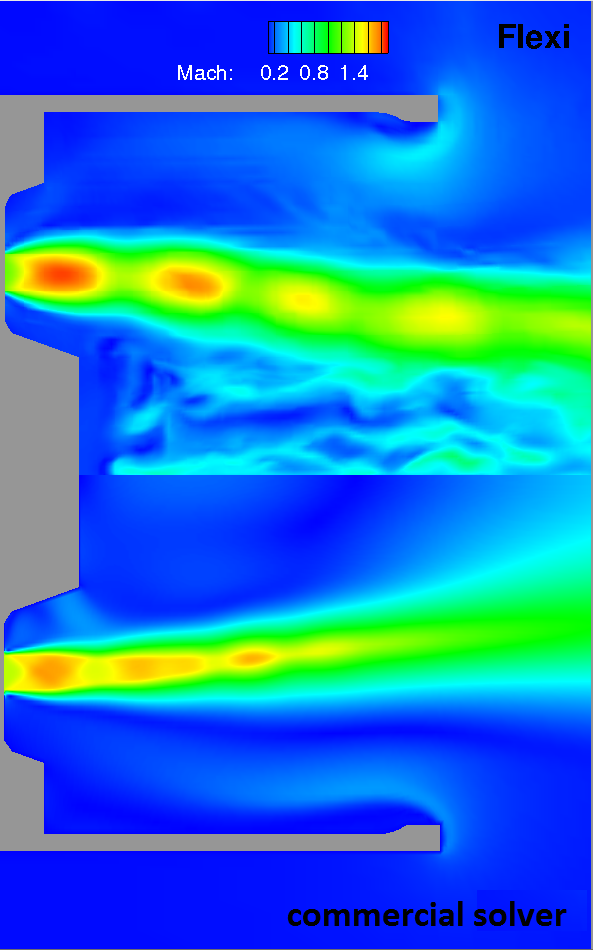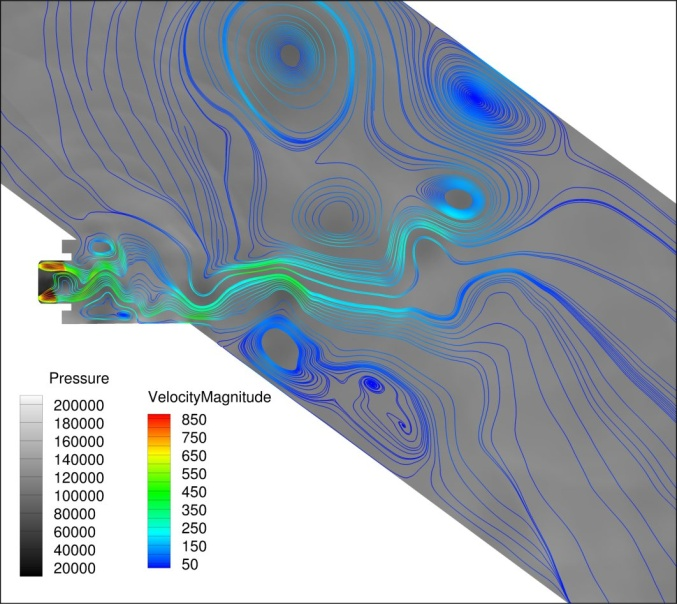Toward a Discontinuous Galerkin Fluid Dynamics Framework for Industrial Applications
For many years, discontinuous Galerkin (DG) methods have been proving their value as highly efficient, very well scalable high-order methods for computational fluid dynamics (CFD) calculations.
However, they have so far mainly been applied in the academic environment and the step toward an application in industry is still waited for.
In this article, we report on our project that aims at creating a comprehensive CFD software that makes highly resolved unsteady industrial DG calculations an option.
First, our focus lies on the adaptation of the solver itself to industrial problems and the optimization of the parallelization efficiency.
Second, we present a visualization tool specifically tailored to the properties of DG data that will be combined with the solver to obtain an in-situ visualization strategy within our project in the near future.
Published in High Performance Computing in Science and Engineering `15, p. 531-545. http://dx.doi.org/10.1007/978-3-319-24633-8
Visualization of 2D Wave Propagation by Huygens' Principle
In this paper, we present a novel technique to visualize wave propagation in 2D scalar fields. Direct visualization of wave fronts is susceptible to visual clutter and interpretation difficulties due to space-time interference and global influence.
To avoid this, we employ Huygens' principle to obtain virtual sources that provide a concise space-time representation of the overall dynamics by means of elementary waves.
We first demonstrate the utility of our overall approach by computing a dense field of virtual sources. This variant offers full insight into space-time wave dynamics in terms of elementary waves, but it reflects the full problem of inverse wave propagation and hence suffers
from high costs regarding memory consumption and computation.
As an alternative, we therefore provide a less accurate and less generic but more efficient approach. This alternative performs wave front extraction with subsequent Hough transform to identify potential virtual sources. We evaluate both approaches and demonstrate their strengths and weaknesses by means of a GPU-based prototype and an implementation on the Cray XC40 Hazel Hen supercomputer, using data from different domains. A possible future area of application for this method is the investigation of acoustic phenomena in computational fluid dynamic simulations.
Presented at the Eurographics Symposium on Parallel Graphics and Visualization 2015 http://dx.doi.org/10.2312/pgv.20151151
On the simulation of industrial gas dynamic applications with the Discontinuous Galerkin Spectral Element Method
In the present investigation, we demonstrate the capabilities of the discontinuous Galerkin spectral element method for high order accuracy computation of gas dynamics. The internal flow field of a natural gas injector for bivalent combustion engines is investigated under its operating conditions. The simulations of the flow field and the aeroacoustic noise emissions were in a good agreement with the experimental data. We tested several shock-capturing techniques for the discontinuous Galerkin scheme. Based on the validated framework, we analyzed the development of the supersonic jets during different opening procedures of a compressed natural gas injector. The results suggest that a more gradual injector opening decreases the noise emission.
Presented at the ISAIF 12th 2015
High Order Discontinuous Galerkin Spectral Element Methods for Transitional and Turbulent Flow Simulations
In this paper, we investigate the accuracy and efficiency of discontinuous Galerkin spectral method simulations of under-resolved transitional and turbulent flows at moderate Reynolds numbers, where the accurate prediction of closely coupled laminar regions, transition and developed turbulence presents a great challenge to large eddy simulation modelling. We take full advantage of the low numerical errors and associated superior scale resolving capabilities of high-order spectral methods by using high-order ansatz functions up to 12th order. We employ polynomial de-aliasing techniques to prevent instabilities arising from inexact quadrature of nonlinearities. Without the need for any additional filtering, explicit or implicit modelling, or artificial dissipation, our high-order schemes capture the turbulent flow at the considered Reynolds number range very well. Three classical large eddy simulation benchmark problems are considered: a circular cylinder flow at ReD=3900, a confined periodic hill flow at Reh=2800 and the transitional flow over a SD7003 airfoil at Rec=60,000. For all computations, the total number of degrees of freedom used for the discontinuous Galerkin spectral method simulations is chosen to be equal or considerably less than the reported data in literature. In all three cases, we achieve an equal or better match to direct numerical simulation results, compared with other schemes of lower order with explicitly or implicitly added subgrid scale models.
http://onlinelibrary.wiley.com/doi/10.1002/fld.3943/abstract
Injection of compressed natural gas into an intake manifold
The injection of compressed natural gas (CNG) into the intake manifold is a highly complex process. The presence of supersonic shock structures, vast difference in time and spatial scales, sound propagation and the mixing process are only a few examples for its complexity. These phenomena and their interaction with other components, such as the intake manifold wall are still not fully understood.
The investigation includes different commercial software and mainly FLEXI and focuses in a first step on the injection process itself and the injection into the intake manifold.
A key point found by the investigation was the difference in dissipation of the numerical schemes. The Mach numbers near the inlet region of the injector display this difference between the FLEXI and commercial solver with comparable degrees of freedom. Further, a radial movement of the shock structures occurs, due to their interaction. The URANS with the commercial solver did not show such an effect.

Currently, the focus is on the modelling of the injection ramp-up. First preliminary results suggest that a faster ramp-up of the injection might lead to increased pressure waves. This is due to two stages in the development of the shock structures. At first individual shock structures of each orifice develop. The second stage is the formation of an interacting system of the different shock structures. The transition between the stages is smoother for a slower ramp-up of the injection.
The injection flow inside the intake manifold displays vortices of different spatial and temporal scales and strong pressure waves bouncing between the walls.
The FLEXI code yields great potential in terms of accuracy and performance and is continually improved by the project partners. Work is put into improvements of the usability, so a transition is possible from a pure research code to an industrial ready CFD application. In the near future cavitation and hydraulic components will be simulated with FLEXI within HONK.



